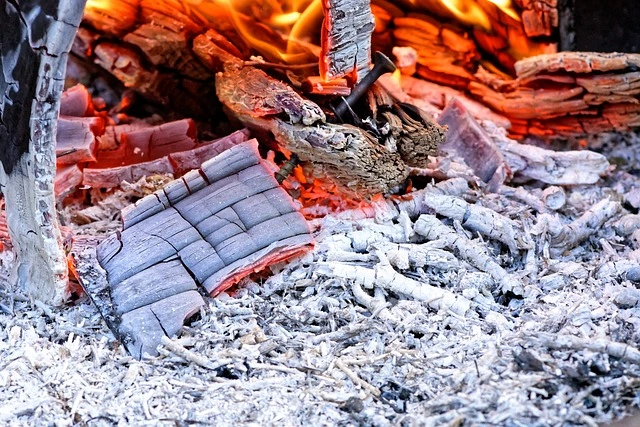The cozy crackle of a fireplace not only serves as a source of warmth and comfort but also a precursor to a variety of eco-conscious practices, thanks to the ashes it leaves behind. As the gentle embers fade into a grey residue, many may see this as the end of a fire’s utility. However, the journey of fireplace ashes extends far beyond the hearth, offering a treasure trove of uses in our gardens, homes, and art studios. This seemingly modest byproduct of burnt wood embodies a potential that’s both diverse and sustainable, answering the often-wondered question What to do with fireplace ashes? Each application of fireplace ashes not only exemplifies a resourceful spirit but also a step towards a greener lifestyle.
As we delve into the myriad ways of repurposing fireplace ashes, we unfold a narrative of creativity, sustainability, and respect for natural resources. Embracing the value in fireplace ashes could foster a more eco-conscious mindset, propelling us towards practices that honor nature’s cyclical design.
Repurposing Fireplace Ashes Beyond the Hearth
As the flames dwindle and the fire in your fireplace extinguishes, a pile of ashes remains as a testament to the cozy warmth that engulfed your living space. Instead of seeing this as a mere residue, consider fireplace ashes as a resource waiting to be repurposed. Here are some inspiring ways to give a second life to the remnants of a comforting blaze.
1. Garden Fertilizer
The beneficial use of fireplace ashes in gardening traces back to ancient cultures. Predominantly composed of calcium carbonate, fireplace ashes act as a lime substitute that neutralizes acidic soils making them more favorable for plant growth. Besides, ashes are rich in potassium which enhances flower blooming and fruit production. They also contain trace amounts of phosphorus, magnesium, and aluminum. When you sprinkle a thin layer of ash over your garden, make sure to work it gently into the soil to aid the better absorption of these nutrients. However, be cautious to avoid direct contact with young plants or seeds as ashes are alkaline and can potentially harm them. It’s essential to test the soil’s pH level before application to ensure it’s the right choice for your garden’s soil composition.
2. Pest Repellent
Fireplace ashes are a traditional, chemical-free deterrent for soft-bodied pests like slugs and snails. The ashes’ caustic nature is unpleasant to these pests, creating a hostile environment that drives them away from your cherished plants. To utilize fireplace ashes as a pest repellent, simply encircle the base of your plants with a barrier of ashes. Not only does this method deter pests, but it’s an eco-friendly and economical choice compared to store-bought repellents. However, moderation is crucial. Too much ash can change the soil’s pH level adversely affecting plant growth. It’s advisable to observe how your plants react to this pest control method and adjust the quantity of ash used accordingly.
3. Composting
Composting is a transformative process that turns organic waste into a nutrient-rich soil enhancer. Adding a moderate amount of fireplace ashes to your compost pile can be beneficial. The ashes add minerals and nutrients, enhancing the compost’s nutritional profile. However, balance is key. Too much ash can make the compost overly alkaline, which may not be favorable for all plants. Moreover, it’s essential to only use wood ashes. Avoid ashes from coal or treated wood as they can introduce harmful substances into your compost. Ensure to mix the ashes well into the compost to avoid clumps, which could create barriers to the necessary aeration within the pile.
4. Cleaning Agent
The fine, abrasive nature of fireplace ashes makes them a suitable candidate for tackling stubborn stains and residues. A paste created from fireplace ashes and a little water can work wonders on silverware, glass, or even stained clothing. This mixture acts as a gentle abrasive, helping to scrub away grime and restore shine to metals and glass. Moreover, utilizing ashes as a cleaning agent is an eco-friendly alternative to chemical-laden cleaning products. It’s a creative way to cut down on waste while keeping your belongings sparkling clean. Before using ashes on delicate surfaces, it’s advisable to test a small, inconspicuous area to ensure it won’t cause any damage.
5. Odor Neutralizer
The porous nature of ashes makes them an effective absorbent of odors. By simply sprinkling some ash on areas prone to foul smells like cat litter boxes or musty spots in the basement, you could significantly reduce unpleasant odors. After letting the ashes sit for a few hours or overnight, sweep or vacuum them up. It’s a simple yet effective method to keep your spaces smelling fresh without resorting to synthetic air fresheners. Moreover, it showcases a resourceful approach to managing household wastes by repurposing them into useful solutions for everyday problems.
6. Creating Lye for Soap Making
Lye is a crucial ingredient in traditional soap-making processes, and one of the age-old methods of obtaining it is through leaching water through fireplace ashes. This leaching process yields lye water, which when boiled down with fats, results in homemade soap. This ingenious reuse not only recycles the ashes but also provides an opportunity to create natural, personalized cleaning products at home. The process of making lye from ashes is a nod to historical self-sufficiency and a creative way to minimize waste. However, it’s essential to handle lye with care as it can be caustic and requires proper safety measures during the soap-making process.
7. Natural Ice Melt
With winter comes the menace of icy walkways and driveways, posing a risk of slips and falls. Here’s where fireplace ashes can come to the rescue. Sprinkling ashes on icy surfaces can help melt ice and provide better traction due to its gritty texture. The dark color of ashes absorbs more solar heat, speeding up the melting process. However, using ashes as an ice melt should be done judiciously as it can be messy, and the residues might get tracked into your home on shoes. Additionally, the ashes can alter the pH of the soil beneath, so it’s wise to use this method in moderation, especially around vegetation.
8. Ceramic Glazing
The ancient art of pottery has intertwined with the practice of using ashes for glazing for centuries. Fireplace ashes, when used in ceramic glazing, bring about a rustic, earthy aesthetic to pottery. When the ash-covered pottery is subjected to high kiln temperatures, the ashes melt, forming a glaze that fuses to the ceramic surface. The result is a unique, beautiful finish, with hues varying based on the ash and clay composition. The recycling of ashes into a glazing material not only yields exceptional artwork but also embodies a sustainable approach to artistry, appreciating nature’s byproducts in creative endeavors.
9. Creating a Backyard Dust Bath for Chickens
For those practicing backyard poultry keeping, maintaining the health of your flock is crucial. A dust bath, essential for chickens’ hygiene and comfort, helps in controlling parasites like mites, lice, and fleas. A mixture of fireplace ashes, sand, and soil creates a fine dust bath that the chickens can frolic in, helping suffocate and dislodge parasites. The ashes are particularly effective in this mixture, acting as a natural pesticide. Ensuring your chickens have a designated area for dust baths not only contributes to their health but also provides them with a natural behavior outlet, making for a happier, healthier flock.
10. Polishing Metal
The gentle abrasive quality of fireplace ashes makes it a splendid ingredient for homemade metal polish. A thick paste made from ashes and water can be applied to tarnished metals, and with gentle rubbing, can help restore the shine to metals like silver and brass. This practice is not only economical but also environmentally friendly, reducing the reliance on commercially available, often chemical-rich polishing agents. The process of polishing metal with fireplace ashes is simple, yet effective, and represents a resourceful way of reutilizing waste materials, showcasing an excellent example of sustainable living practices.
Conclusion
The voyage of fireplace ashes from the hearth to beneficial use instances reflects a conscientious approach to resource utilization, forming a beautiful narrative of turning waste into worth. By adopting such eco-friendly practices, individuals not only contribute to sustainable living but also engage in a profound dialogue with nature, learning to find utility in the overlooked. The versatility of fireplace ashes serves as a testament to nature’s enduring capacity to sustain, nurture, and inspire. Moreover, repurposing fireplace ashes cultivates a realm where creativity meets sustainability, resulting in a harmonious relationship between humans and their environment. The seemingly humble fireplace ash indeed holds within it a spectrum of possibilities waiting to be explored, beckoning us to look beyond the obvious, towards a horizon where every byproduct has a purpose, every end has a new beginning.




